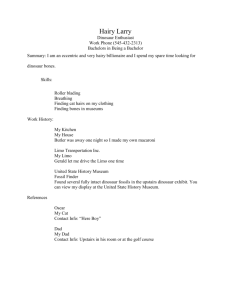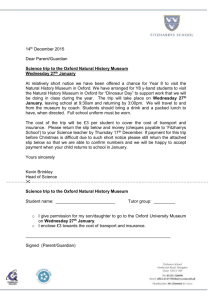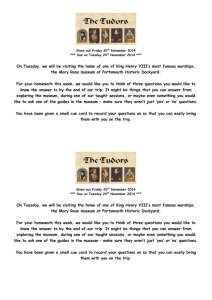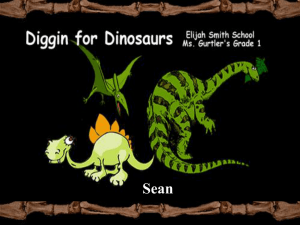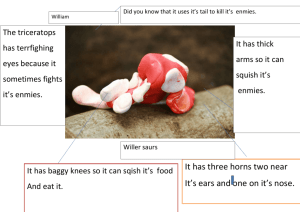doc - Eastern Missouri Society for Paleontology
advertisement
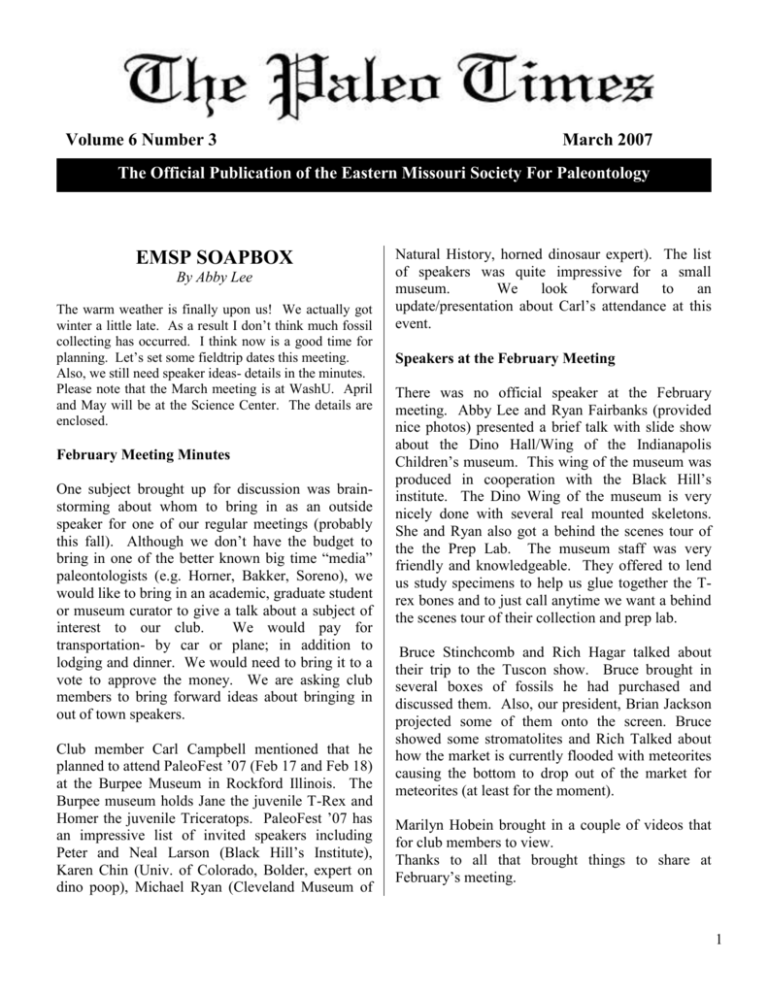
Volume 6 Number 3 March 2007 The Official Publication of the Eastern Missouri Society For Paleontology EMSP SOAPBOX By Abby Lee The warm weather is finally upon us! We actually got winter a little late. As a result I don’t think much fossil collecting has occurred. I think now is a good time for planning. Let’s set some fieldtrip dates this meeting. Also, we still need speaker ideas- details in the minutes. Please note that the March meeting is at WashU. April and May will be at the Science Center. The details are enclosed. February Meeting Minutes One subject brought up for discussion was brainstorming about whom to bring in as an outside speaker for one of our regular meetings (probably this fall). Although we don’t have the budget to bring in one of the better known big time “media” paleontologists (e.g. Horner, Bakker, Soreno), we would like to bring in an academic, graduate student or museum curator to give a talk about a subject of interest to our club. We would pay for transportation- by car or plane; in addition to lodging and dinner. We would need to bring it to a vote to approve the money. We are asking club members to bring forward ideas about bringing in out of town speakers. Club member Carl Campbell mentioned that he planned to attend PaleoFest ’07 (Feb 17 and Feb 18) at the Burpee Museum in Rockford Illinois. The Burpee museum holds Jane the juvenile T-Rex and Homer the juvenile Triceratops. PaleoFest ’07 has an impressive list of invited speakers including Peter and Neal Larson (Black Hill’s Institute), Karen Chin (Univ. of Colorado, Bolder, expert on dino poop), Michael Ryan (Cleveland Museum of Natural History, horned dinosaur expert). The list of speakers was quite impressive for a small museum. We look forward to an update/presentation about Carl’s attendance at this event. Speakers at the February Meeting There was no official speaker at the February meeting. Abby Lee and Ryan Fairbanks (provided nice photos) presented a brief talk with slide show about the Dino Hall/Wing of the Indianapolis Children’s museum. This wing of the museum was produced in cooperation with the Black Hill’s institute. The Dino Wing of the museum is very nicely done with several real mounted skeletons. She and Ryan also got a behind the scenes tour of the the Prep Lab. The museum staff was very friendly and knowledgeable. They offered to lend us study specimens to help us glue together the Trex bones and to just call anytime we want a behind the scenes tour of their collection and prep lab. Bruce Stinchcomb and Rich Hagar talked about their trip to the Tuscon show. Bruce brought in several boxes of fossils he had purchased and discussed them. Also, our president, Brian Jackson projected some of them onto the screen. Bruce showed some stromatolites and Rich Talked about how the market is currently flooded with meteorites causing the bottom to drop out of the market for meteorites (at least for the moment). Marilyn Hobein brought in a couple of videos that for club members to view. Thanks to all that brought things to share at February’s meeting. 1 Upcoming Events March Meeting. Please note that originally the March meeting was going to be at the Science Center. However, due to a scheduling conflict, the Science Center is unavailable the evening of March 9th. Therefore the March meeting of the Eastern Missouri Society for Paleontology will be on Friday, March 9th, 2007 at 7:30 pm in room 203 of the new Earth & Planetary Sciences Building on the campus of Washington University. The speaker for March will be WashU professor Carrine Blank, who will talk about the origin of early life on Earthpossibly including stromatolies. For those that arrive late to the meeting, a cell phone number will be posted on both doors to call. Someone will come down to promptly let you in, but please try to arrive on time. on your newsletter address label. See Pete at the next meeting or mail a check (payable to Eastern Missouri Society for Paleontology) to: EMSP P.O. Box 220273 St. Louis, MO. 63122 Raffle A new raffle item was donated by Dave Lukens. It is a Venus Clam from Rock Pit, FL thought to be 1 million years old. The clams are fossilized with napier intact and beautiful crystals inside. The clams hit the market only recently. The sell for over $100.00 on line and at shows. More about this at up-coming meetings. Field Trips April and May Meeting: Meetings will be held at the St. Louis Science Center and open to the public. Speakers include Janis Tregworthy (in May) updating us on her mammoth at Principia college, Mike Fix (in April) on the Chronister site dino project. Jon McLeod is/or will be asked about presenting this year as well. He is a member and paleontologist. There was a field trip to Cedar Creek scheduled for Saturday, February 17th. Bruce Stinchcomb was the leader for the trip. The trip was set for above freezing weather. It was supposed to snow that day so I personally took a pass (I = Abby Lee). If the trip did take place please bring your finds for show and tell. Summer picnic. Rich Poropat has reserved the Kirkwood park pavilion for July 29th for our annual summer picnic. Bruce has also been willing to lead a trip to the Barite Pit for Cambrian fossils on one of these nice weekends soon. Perhaps we will pin down a trip to this location this spring, as well. MAPS EXPO 2007- March 30th-April 1st in Macomb, IL. Maps is the largest all fossil exposition in the U.S. The trip is well worth it. A university basketball stadium is filled with booths from national and international dealers. Cash is the recommended currency. The drive is a manageable day trip form St. Louis. However, two days are required to really look at everything. Hotels fill ups quickly for the weekend. There will be more discussion of this event at the March meeting. Kansas River – tentatively set for April- weather permitting and depending on the level of the river. Bruce Wake of Kansas City replied to my request for a Kansas River canoe trip. He has graciously offered his home- sleeping up to 8, for arriving Friday night, canoeing on Sat, and leaving on Sunday. This trip offers the opportunity to collect Pleistocene-age bones, as well as, not quite so old bison bones. DUES ARE DUE Our treasurer, Pete Smith will accept dues payment for a full year. Dues are $15.00 per household per year and are payable on the anniversary date printed Distribution of the Newsletter by email We keep adding to the list of club members who have elected to receive the newsletter by email. Many will go out by email this month. This is a cost savings measure for the club. Each newsletter 2 currently costs 39 cents to mail. This is over $4.00 per person each year for postage alone. A sign-up list will be available at meetings, or email Tom Lee (motirek@gmail.com) to begin to receive the newsletter electronically. Paleo-shorts The presence of this open zone of mantle is very rare and no current theory explains the process by which mantle has become exposed. The area of study lies beneath 2 miles of ocean mid-way between the Cape Verdes Islands and the Caribbean. The open zone of mantle extends over thousands of square kilometers. Fossilized tissue found in ancient fish (Summarized from a UPI news release -Perth, Australia, Feb 14.) It was reported that Australian scientists have discovered fossilized muscle tissue in two armored fish known as placoderms. The fish were discovered in western Australia about 20 years ago. The fossils are estimated to be 380 million years old. “It’s quite a substantial area” according to Chris MacLeod, a marine geologist at Cardiff University in the UK, who will be part of the expedition. Placoderms are an extinct group of primitive armored fish. The soft tissue preserved was revealed on inspection using scanning electron microscopy and probably represents the oldest recorded instance of muscle cells, blood vessels, and nerve cells. Although the fossils were discovered many years ago, they were only recently evaluated using this high resolution method. According to MacLeod, “scientists have known about such anomalies for years, but it is only within the past decade that they have actively begun investigating them.” Interestingly, the fossils were not flattened, but maintained their three-dimensional structure. The fossils clearly shed new light on the evolution of placoderms, which were a dominant group in oceans and rivers for over 70 million years and the first jawed vertebrates. They went extinct approximately 360 million years ago. The lead study author was Kate Trinajstic, a paleontologist at the University of Western Australia. Earth’s Mantle Exposed. The earth is covered by a thick hard shell-like crust that is approximately 20 miles thick over the continents and about 4 miles thick over the ocean floor. Beneath the Earth’s crust is the mantle, which is a hotter, more fluid structure than the crust. Apparently, there is an “open wound” on the Atlantic seafloor where the mantle is exposed. A team of scientists is headed for this zone in February 07 to study this exposed zone of mantle. MacLeod explains that our current understanding of marine geology doesn’t explain how this “open wound” on the sea floor was formed. He expects to gain new insight into how this zone was formed on the currently planned expedition. MacLeod explains that there are two current hypotheses about the exposed mantle. One hypothesis contends that the mantle was once covered by crust, but the crust was ripped away. He compares this process to that of stretching a person’s skin until it ruptures. The other hypothesis purports that somehow the area of exposed mantle was never covered by a magma crust in the first place. Regardless of how the mantle became exposed, it provides a rare opportunity to drill into the mantle and sample its contents. MacLeod explains that recovering samples of the mantle is not as easy as it sounds. The drilling equipment will be exposed to tremendous pressure and steep slopes when in operation. The research team is led by Roger Searle of Durham University, and will embark to the site on March 5, 2007 aboard the new UK research ship “RSS James Cook.” The mission will take six weeks. The team will use sonar to image the seafloor and a robotic seabed drill to collect rock cores. 3 Cleveland Museum of Natural History Scientist Discovers New Horned Dinosaur Genus (Summarized from a media release from the Cleveland Museum of Natural History, Feb 24, 2007). Paleontologist Michael J. Ryan, Ph. D, and Curator of Vertebrate Paleontology Scientist at The Cleveland Museum of Natural History, has announced the discovery of a new horned dinosaur, named Albertaceratops nesmoi. This plant-eating dinosaur was approximately 20 feet long and the weight of a pickup truck. The dinosaur was found in southern Alberta, Canada. The new genus of horned dinosaur dinosaur lived nearly 78 million and is important because it provides additional insight into the evolutionary history of the Ceratopsidae dinosaur family. This is only the second new horned dinosaur species found in Canada since the 1950s. The results for this new genus and species are reported in the latest volume of the Journal of Paleontology. There are two subfamilies of the horned dinosaur family Ceratopsidae. Albertaceratops nesmoi belongs to one of the sub-families, called the Centrosaurinae. Dr. Ryan explains that this new dinosaur is exciting because it has very long brow horns. Most members of the Centrosaurinae have very short horns over their eyes, but long horns over their nose and spikes or hooks coming off of the back of the frill. The long brow horns are more characteristic of the other subfamily, Chasmosaurine, which includes Torosaurus and the very familiar Triceratops. Albertaceratops nesmoi pre-dates Triceratops by 10 million years. explained Ryan. The new dinosaur also had two large, thick hooks that curl forward from the corners of the creature’s frill. Ryan speculates that “the long horns could have been used for either sexual display or self-defense against the giant predatory tyrannosaur, Daspletosaurus that roamed the region.” Ryan also explained in the media release that: “Analysis shows that Albertaceratops nesmoi was the most primitive member of the Centrosaurinae, and that it is placed just above the split that separated them from the group that includes Triceratops.” The media release explained that Albertaceratops nesmoi is named to honor both the province where the new dinosaur was found and Cecil Nesmo, a local rancher who has been very supportive of paleontology research on his land. The specimen was found just north of the Montana border in a very remote region. Ryan is apparently close to announcing the find of one additional strange-horned from the same region. .Reference: A NEW BASAL CENTROSAURINE CERATOPSID FROM THE OLDMAN FORMATION, SOUTHEASTERN ALBERTA. 2007. Michael J. Ryan. Journal of Paleontology Vol. 81, No. 2, pp. 376–396. DOI: http://dx.doi.org/10.1666/00223360(2007)81[376:ANBCCF]2.0.CO;2 According to Ryan, “We knew that we had something special that we had never seen before—it meant that while Triceratops had giant horns, some centrosaurs did, too.” Besides having long brow horns, Albertaceratops nesmoi has a long, low banana-shaped bump in place of a nasal horn, 4 What is EMSP? The Eastern Missouri Society for Paleontology (EMSP) is a not-for-profit organization Dedicated to promoting the enjoyment of fossil collecting. It is open to all individuals interested in learning about the history of life on earth. The club membership includes professional paleontologists as well as amateur hobbyists. The EMSP provides an open forum for the exchange of information and access to expertise on collecting, identifying, preparing and displaying fossils. EMSP meetings are held on the second Friday of every month (except July, August and December) at 7:30pm in the Earth and Planetary Sciences Buildingon the campus of Washington University. Each meeting includes an informal exchange of information and speakers on a variety of fossil-related topics. Weather permitting, field trips to fossil collection localities around the St. Louis area are held each month. Led by experienced collectors, these trips are a fun way to augment discussions at the monthly meetings. The club participates in joint field trips with other paleo clubs, visiting fossil sites throughout the United States. EMSP is also a proud to be involved in partnerships with the St. Louis Science Center and the Greater St. Louis Association of Earth Science Clubs, Inc. Eastern Missouri Society For Paleontology (EMSP) P.O. Box 220273 St. Louis, MO. 63122 FIRST CLASS MAIL 5
